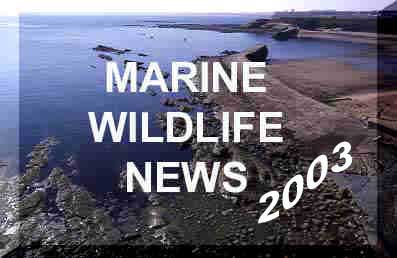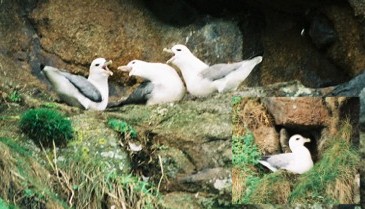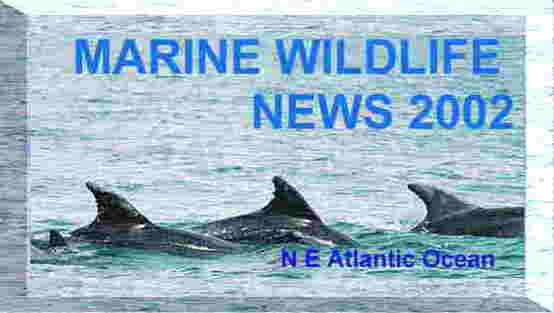
|
|
|
|
|
(BMLSS *** Site) |
|
|
|
Norwegian Marine*** |
|
L-I-N-K-S to Other Sites (Click on Text) |
|
Smart Group |
 |
|
|
|
|
|
|

WINTER 2004
Reports of marine wildlife from all around the British Isles, with pollution incidents and conservation initiatives as they affect the fauna and flora of the NE Atlantic Ocean.
on Microsoft Internet Explorer (best) or Netscape
 |
 |
 |
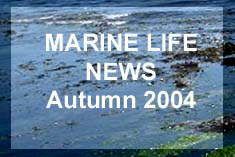 |
LATEST NEWS: WINTER 2004
27 March 2004
A former Royal Navy frigate has been sunk off Cornwall to create the UK's first artificial diving reef. Thousands of people watched from Whitsand Bay near Plymouth as HMS Scylla was scuttled at 3:28 pm GMT.
The explosives were detonated by 12-year-old Daniel Green, from Ivybridge, Devon, accompanied by environmentalist David Bellamy.
BBC News Report
The position of the Scylla Artificial Reef is 50º 19.64 ´N 004º 15.20´W with the bow facing south-west, about 800 metres from the wreck of the James Eagan Layne. It is on the bottom at 20 metres below Chart Datum and listing 20º to starboard. The sea bottom is dark granule sand.
1 April 2004
The diving team at the National Marine Aquarium were the first civilian divers to ever dive on the unique Scylla reef, after the Royal Navy divers had been down to inspect the sunken warship.
The first fish to arrive was a Ballan Wrasse, Labrus bergylta.Additional Report by Doug Herdson (National Marine Aquarium, Plymouth)
on the Marine Wildlife of the North-east Atlantic Ocean Group
26 March 2004
AHooded Seal, Cystophora cristata, was discovered on St. Ives beach, Cornwall, by British Divers Marine Life Rescue. The Hooded Seal is an Arctic species and even discoveries off the coast of Scotland, including the Orkney and Shetland Isles are rare. It moults around Greenland and the Denmark Strait (between Iceland and Greenland).
British Divers Marine Life Rescue News Page (with the Full Report)
Hooded Seal 2001 (SW Wales)
BMLSS Seals21-22 March 2004
A 12 metre long Sperm Whale, Physeter catodon, was washed up still alive on a sand bank at Sutton Bridge in The Wash, on the east coast of England, and first spotted by a local resident at 10:00 am on 21 March 2004. Unfortunately the distressed whale was stuck on the sandbank and the rescuers are powerless to assist the 15 tonne animal back into deeper water. Efforts were made to help it stay alive and to hope it will have the strength and luck with the tides to free itself. The prognosis is poor for any chance of survival.
Unfortunately, the whale died on the second day.
BBC News Report
British Divers Marine Life Rescue News Page
BMLSS Cetacea21 March 2004
The head of the cetacean skeleton (see below) has now been discovered.I think the length of the beak indicates a Harbour Porpoise, Phocoena phocoena.
17 March 2004
A photograph reached Kent & Medway Biological Records Centre via the Environment Agency. An angler (A.K. Bushell) caught and photographed a Chinese Mitten Crab, Eriocheir sinensis, (pic) from Gillingham Pier, Kent. This crab is a non-native species that burrows into river and coastal banks. As this individual was a typical size of approx. 28 cm across, you can see that burrowing can help cause severe bank erosion. Consequently, the Environment Agency would like to know of any records of this species to monitor the current spread of this species.
Kent & Medway Biological Records Centre Monthly Records 200414 March 2004
A headless skeleton of a 120 cm long cetacean is washed up on the shore at Low Newton, in Northumberland, north-east England.The head is missing and the bit where the head should be probably tucks underneath the skeleton. It is most likely a Harbour Porpoise, Phocoena phocoena, and these are probable too commonly washed up to be newsworthy, but rarely is anything like a complete skeleton photographed. The image on the far right shows the bone structure of a cetacean (the method of swimming can be ascertained from these remains).
Report and Photographs by Frances StockdaleBMLSS Cetacea
BMLSS Beachcombing9 March 2004
A large male Thresher Shark, Alopius vulpinus, was landed to Plymouth Fish Market. It had been caught by midwater pair trawlers fishing for Bass. It weighed 258 kg and was 416 cm in total length (207 cm precaudal length).Report from Doug Herdson (National Marine Aquarium, Plymouth)BMLSS Sharks
on the Marine Wildlife of the North-east Atlantic Ocean Group2 March 2004
An unusual high numbers of Fulmars, Fulmarus glacialis, were found dead on the beaches in Northern France and Belgium. Since the end of last week, probably more than 200 have already been picked up dead.Report by Benoît Paepegaey (Association "Le Clipon" Maison de l'Environnement)
on Euro-Seawatching Yahoo Group
This seems to be the first report of mass fatalities and unusually high numbers of Fulmars in the North Sea, with other reports from Norfolk and even stray birds inland.
Fulmar Notes (More Information)
On 12 March 2004, 59 Fulmar corpses were found on a three mile section between Wells and Holkham, north Norfolk, including 11 'blue phase' birds. Other dead sea birds of 13 different species were also discovered, plus 30 live Snow Buntings, Plectrophenax nivalis.
29 February 2004
154 Fulmars passed Flamborough Head, Yorkshire, (there had been 46 the previous day). This is the highest ever count at Flamborough. Pacific Fulmar Mass Mortalities 2003The current Fulmar wreck appears not to be triggered by instantaneous events in terms of food-shortage, pollution incidents, unfavourable weather or disease. The problems of the birds date back to at least October last year, 2003, or probably earlier.
Full Report by J.A. van Franeker
Dutch Seabird Group
Historic Reports27 February 2004
An adult male Sperm Whale, Physeter catodon, measuring nearly 15 metres in length was found stranded on the Oostduinkerke beach in Belgium. Judging by its advanced state of decomposition the large whale, the twenty-first to have been discovered on Belgium beaches since 1403, had been dead for several months before it washed up on the beach.
French News ReportReport by Yvon Godefroid on UK Cetnet
24 February 2004
A Leatherback Turtle, Dermochelys coriacea, was spotted five miles south of Mevagissey off the south coast of Cornwall. This is an unusually early sighting. They normally start appearing in UK waters in early summer.
Newquay resident Jo Leach reported the turtle after spotting it while out on her uncle's crab potting boat.
“My uncle was using his binoculars to look out for the Fin Whales that had been reported over the weekend, when he saw something that he thought looked like a rock breaking the surface”, said Jo Leach, “We approached the object and cut the engines, and when we were about five metres away we could see it was a Leatherback Turtle. It gazed at us for a few minutes and then slowly swam off, as if it had had enough of looking at us!”Report by the Marine Conservation SocietyUK Turtle Code
BMLSS Turtles17 February 2004
A seal was spotted in the River Thames, London, by Richmond Bridge. It was about 120 cm in length. It was most likely a Common Seal, Phoca vitulina.Report by Phil Stubbs2 February 2004
14 February 2004
Four Fin Whales, Balaenoptera physalis, and a large pod of Common Dolphins, Delphinus delphis, were spotted from the Orca Seafaris boat approximately 18 miles off the Roseland Peninsular, Cornwall.
A Fin Whale, Balaenoptera physalis, was found washed ashore on the island of Coll, the second found beached on a Hebridean island in recent weeks. The 17 metres long carcass was found by an islander. This whale was in a fresh condition.
News Report
The earlier whale washed up on Mull was a beaked whale of a species not known at the time of writing.Corrected report by Dr. Peter G.H. Evans on UK CetnetSea Watch Foundation
BMLSS Cetacea30 January 2004
A pod of Risso’s Dolphins, Grampus griseus, and then the even larger fin cleaved through the water, the black and white flanks revealing two Killer Whales, Orcinus orca, were spotted by a large groups birdwatchers off Fishguard, south-west wales. These large cetaceans were a mile out to sea and seen through the birdwatchers scopes.
BBC News Report
Cetacean Sightings off Wales29 January 2004
A "skein" of dolphins were observed in the sea off Widewater Lagoon, Lancing, Sussex at 2:00 pm in the afternoon. This was an unusual event off the Sussex coast and most occasional observations have been in the summer months. Pods of dolphins have been seen off Selsey Bill, West Sussex in the last few days. "Skein" is the term used by the observer and I have not known this collective noun used before for cetaceans.Hearsay Report by Brian Street (Shoreham)Adur Valley Nature Notes (January 2004)
Nature Notes Webring
The Sea off Sussex
BMLSS Cetacea28 January 2004
A 12 metres long Sperm Whale, Physeter catodon, was washed up dead at Thornham Norfolk.Photograph by Richard Saunders
For spotters willing to brave the gale force winds, the whale could be seen by transversing the muddy trail from Holme NWT and following the sea bank to the beach.
Lynn News Report
The Porcupine Marine Natural History Society web pages are launched. Please click on the logo to access their pages.
The Marine Conservation Society UK Turtle Code is now online at http://www.euroturtle.org/turtlecode/
26 January 2004
BMLSS Cetacea
A Cuvier’s Beaked Whale, Ziphius cavirostris, was washed up dead west of Torloisk on the north west coast of Mull, Inner Hebrides.
Cuvier’s Beaked Whale is a deep water species that feeds on squid and is rarely seen alive or dead in Hebridean seas.
17 January 2004
The pretty bivalve mollusc Moerella donacina (pic) was collected by the Kent Shoresearch group at Sandwich Bay. This is the first known record of the mollusc from this area. The record was submitted by F. Booth.
Kent & Medway Biological Records Centre Monthly Records 2004
Subsequent Record
BMLSS Molluscs10 January 2004
Whilst bird watching around Poole Harbour our search for grebes and divers, we were halted by the appearance of at least ten Bottle-nosed Dolphins, Tursiops truncatus, off Studland, Poole Bay, Dorset just before 11:00 am. The pod were very active with complete breaching by one animal noted on two occasions and lots of tail slapping throughout the observation. They were just at the end of the main shipping channel off Pilots Point.Report by Shaun Robson on UK Cetnet
5 January 2004
A pod of about 500 - 750 dolphins were reported a half mile off Looe, Cornwall, by Polperro trawler "Girl Jane". The majority were probably Common Dolphins, Delphinus delphis.Report by Jon Makeham on the Cornish Mailing ListPair Trawling Threat to the Superpod (News Report)
30 December 2003
Approximately 500 - 750 Common Dolphins, Delphinus delphis, were seen in Falmouth Bay, Cornwall, between 11.30 am & 12.00 pm, heading towards the Lizard. The dolphins were seen made from the Orca-Seafaris boat by Keith Leeves, Suzi Gilpin, Caroline Curtis, Gary Hawkins, Dan, Phil & Dave Jarvis & others.
Report by Dave Jarvis on the Cornish Wildlife Mailing List28 December 2003
A rorqual whale of over 30 tonnes is washed up dead on the sandy shore of the bay of Audierne, between Tronoën and the Torch, near Plomeur near Quimper, southern Brittany, France. Samples have been taken by Oceanopolis, Brest (Public Aquarium) who identified the species as a Fin Whale, Balaenoptera physalis, that had recently died and measured 19.5 metres in length.
Full Report
All reports by Andy Horton unless the credits are given to other observers or reporters.
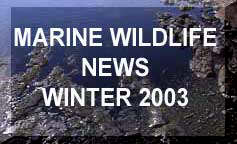 |
 |
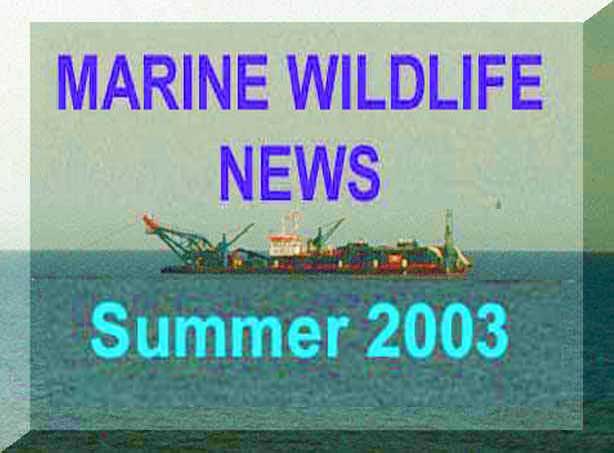 |
 |
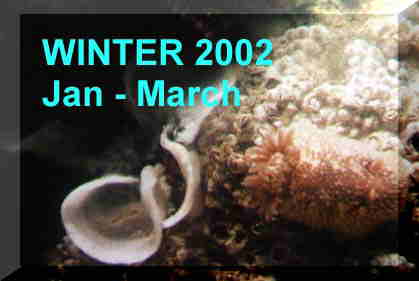 |
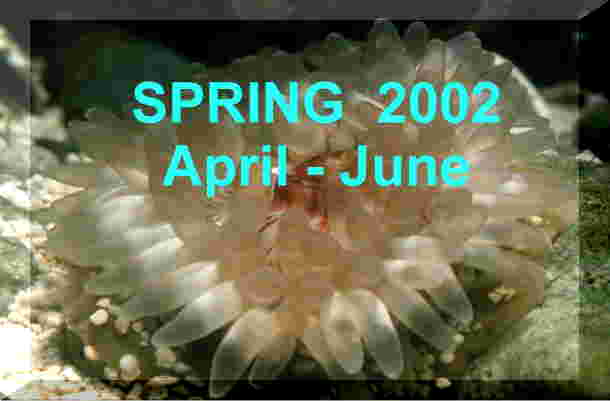 |
 |
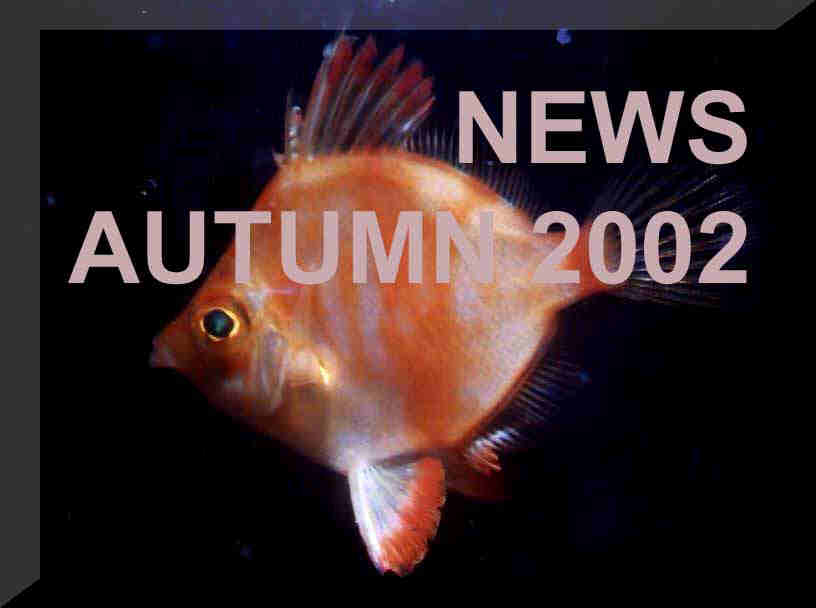 |
FOR EARLIER REPORTS CLICK ON THE BUTTON BELOW

The Marine Wildlife of the NE Atlantic Forum commences.
PLEASE JOIN

MARINE WILDLIFE of the NE ATLANTIC EFORUM PAGE (LINK TO)
Nature Notes Webring
News 2002
News 2001
News 2000
News 1999
|
Use these links if your are familiar with the scientific classifications of marine life |
The BMLSS (England) site commenced on 1 January 1997.
|
|
 |
 |
Andy Horton, Webmaster
|
|
|
|
|
|
Membership Form |
News 2001 News 2000 |

